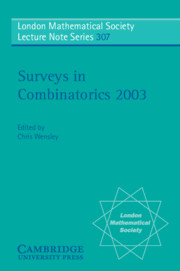Book contents
- Frontmatter
- Contents
- Preface
- W.T. Tutte, 1917–2002
- 1 Decompositions of complete graphs: embedding partial edge-colourings and the method of amalgamations
- 2 Combinatorial schemes for protecting digital content
- 3 Matroids and Coxeter groups
- 4 Defining sets in combinatorics: a survey
- 5 Finite projective planes with a large abelian group
- 6 Algorithmic aspects of graph homomorphisms
- 7 Counting lattice triangulations
- 8 Partition regular equations
- 9 Kostka–Foulkes polynomials and Macdonald spherical functions
2 - Combinatorial schemes for protecting digital content
Published online by Cambridge University Press: 05 May 2013
- Frontmatter
- Contents
- Preface
- W.T. Tutte, 1917–2002
- 1 Decompositions of complete graphs: embedding partial edge-colourings and the method of amalgamations
- 2 Combinatorial schemes for protecting digital content
- 3 Matroids and Coxeter groups
- 4 Defining sets in combinatorics: a survey
- 5 Finite projective planes with a large abelian group
- 6 Algorithmic aspects of graph homomorphisms
- 7 Counting lattice triangulations
- 8 Partition regular equations
- 9 Kostka–Foulkes polynomials and Macdonald spherical functions
Summary
Abstract
When digital information is widely distributed in some fashion, the distributor would often like to trace the source of pirate copies of the information. The paper surveys some of the schemes that have been proposed to achieve this aim, especially emphasising the underlying combinatorics involved. In particular, codes with the identifiable parent property, frameproof codes, secure frameproof codes, traceability schemes and related concepts are surveyed.
Introduction
Nowadays a vast amount of data is distributed in digital fashion (music, film and software being three important examples). Purchasers of the data want easy access, and data providers want to make sure that their data is not pirated. This paper concentrates on one specialised problem in this huge research area, where combinatorial methods have been especially useful. A rough description of the problem is as follows. A traitor is a user who is allowed access to the data (because, for example, they have paid a subscription fee) but who passes on data to an unauthorised third party, a pirate. There could be several traitors, all with different versions of the data, and all giving the information they know to the pirate. The pirate then creates a new version of the data to share with other unauthorised users. How can the data provider identify a traitor, if the provider comes into possession of the pirate's new version?
- Type
- Chapter
- Information
- Surveys in Combinatorics 2003 , pp. 43 - 78Publisher: Cambridge University PressPrint publication year: 2003
- 10
- Cited by



